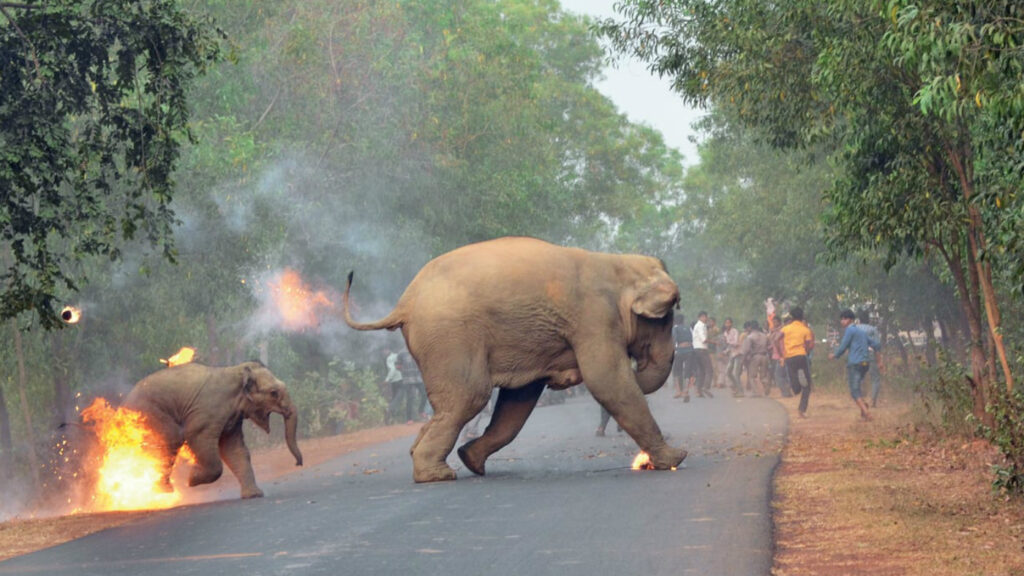India has the most significant number of wild Asian Elephants, estimated at 29,964 according to the 2017 census by Project Elephant, i.e., about 60% of the species’ global population. Friction between humans and elephants, termed Human-Elephant Conflict (HEC), occurs mainly over space and is a significant conservation concern across the country for governments, conservationists, and people living close to wild animals. Loss of natural habitat and fragmentation have brought wild elephants closer to human habitations, sparking these conflicts.
Over 500 humans are killed in encounters with elephants annually, and crops and property worth millions are also damaged. Many elephants are also killed in retaliation due to conflict. To tackle such conflicts and avoid losses on both sides, it is essential to strengthen human-elephant coexistence through active management interventions by the State Forest Departments, involvement of various stakeholders, and sensitization and generating awareness in local communities of forest fringe areas. Multiple management strategies and practices have been developed, customized, and implemented at different scales by the State Forest Departments for preventing and mitigating human-elephant conflict.
Though most existing prevention strategies are based upon site-specific factors that offer short-term solutions, many interventions adopted have successfully removed elephants from human habitations. In densely populated subcontinent, elephants and people have had to increasingly share land and resources, leading to frequent and often fatal conflict. How can the government resolve this problem? Janaki Lenin and Raman Sukumar recently submitted a lengthy report on the issue. Here is a list of the information.
The Stats around Human-Elephant Conflict
- Only 22 percent of elephant habitat is found within our protected area network – the remaining elephant range lies outside, in places now overrun by people.
- The estimated 28,000 wild elephants in India are distributed over about 3% of the country’s geographical area.
- An average of 350 people have been killed annually over the last five years (2006–10) in the conflict with elephants.
- Elephants damaged an average of 330 sq km of crops annually for the last three years (2008–10).
- The Central and State Governments spend 10 to 15 crore rupees yearly on controlling elephant depredation and paying ex-gratia to affected people.
- Annually, between 40 to 50 elephants arekilled in retaliation to crop-raiding
Losses are heavy on both sides. Villagers destroy forests in the belief that it will prevent the animals from using the area, leaving the elephants caught in the pincer grip of habitat fragmentation and retaliation. The conflicts tend to marginalize an already impoverished group -farmers with small holdings cannot withstand the risks posed by the conflict, and in some extreme cases, they have even forced to abandon their farms. The interface between intensifying agriculture and diminishing elephant range is where most conflict occurs. Most current solutions apply short-term conflict mitigation in these areas and achieve limited success.
What is done to minimize human-elephant conflict?
Traditional methods like prayer, noise (shouting, beating drums, burning bamboo, bursting firecrackers), light (fire at entry points to fields, powerful spotlights), and missiles (stones, spears). Machans or huts at ground level are used as lookouts and manned by individual farmers or groups guarding several fields cooperatively. Studies have shown that such tactics have helped reduce crop loss significantly. However, farmers must stay awake over several nights, continuously limiting its viability. People also endanger their lives by getting too close or directly confronting elephants.
Well-maintained barriers keep elephants away from farmland but may direct them to unprotected adjacent villages. Fences and trenches are made ineffective by people who need access to forests.

What about using barriers to mitigate human-elephant conflict?
Poorly planned barriers – that do not consider elephant behavior and landscape use – can be just as bad as obstructions such as highways, railroads, or canals. An example of a poorly planned barrier —denying elephants access to a critical water source or foraging area. In Bandipur, a trench separates the Reserve Forest from the National Park, with elephants on both sides.
Instead of excluding elephants from the human landscape, the barrier prevents them from moving between forests. The West Bengal Forest Department installed a 70 km electric fence to stop the elephants from Dalma Wildlife Sanctuary (Bihar) from crossing the state boundary. When the elephants began to damage crops in Bihar, the local people secretly cut the fence.
Bio-fences such as agave and cacti are ineffective. Providing alternate forage sources by planting food trees and bamboo over large areas takes time and effort. In Jaldapara Wildlife Sanctuary, bamboo and fodder grass planted by the Forest Department encouraged the elephants to stay within the park. However, the steps were frustrated by villagers who grazed their livestock, illegally collected firewood fodder, and caused wildfires.
Chilli and tobacco-laced fences seem more effective in low rainfall areas and deterring elephant herds than bulls. Such chemical deterrents should be used as a novel weapon just before crop harvest (when damage typically peaks) to prevent the animals from getting used to it.
Conclusion
The Forest Departments aid villagers by removing elephants perceived to be dangerous, either by capture, translocation, or killing. However, reducing elephant populations has little effect on conflict. The northeastern Kodagu (Karnataka) area has few forests left and a low estimated elephant density, yet it suffered more friction than the rest of the district. In Assam, while the elephant population is decreasing, conflict is escalating. Conversely, the Nilgiri Biosphere Reserve has high elephant densities, but crop loss was considered low.
Help us Help Them! Think Wildlife Foundation is a non profit organization with various conservation initiatives. Our most prominent campaign is our Caring for Pari intiative. Pari is a rehabilitated elephant at the Wildlife SoS Hospital. 25% of the profits from our store are donated to the elephant hospital for Pari. Other than buying our wonderful merchandise, you could donate directly to our Caring For Pari fundraiser.
Written by: Shreya Pandey
